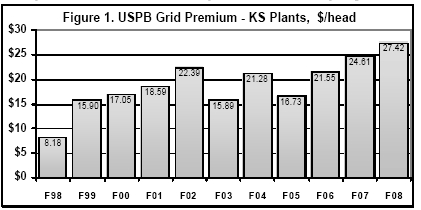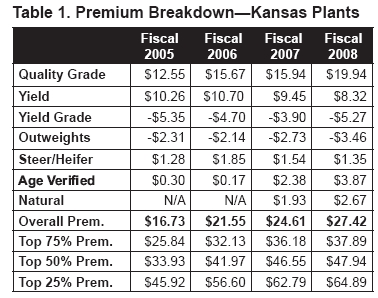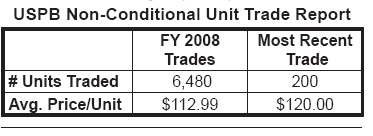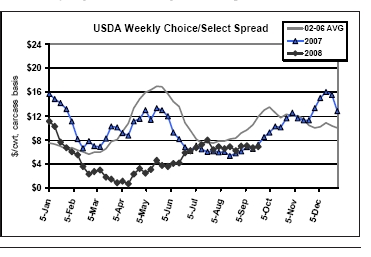
Producers deliver 99.9% of cattle requirements in FY ‘08 | Total grid premiums were highest in company history |
USPB Pays Record Grid Premiums By Steve Hunt, CEO In fiscal year 2008, U.S. Premium Beef set a record for average per head grid premiums. Members who delivered cattle to all of USPB’s plants received an average of $26.89 per head above the cash market. That number is even more impressive given the fact that the average Choice/Select spread was $3.35 lower in 2008 compared to fiscal year 2007. Regarding financial results, our fiscal year ended on August 30 and final results are not yet available. However, we are encouraged by our company’s strong performance during the first three quarters of the fiscal year. Fiscal year 2008 also saw our members deliver the largest number of cattle since fiscal year 2003— In total, USPB paid more than $19.7 million more than 99% of their delivery obligations. One of USPB’s services to our unitholders is to facilitate the leasing of their delivery rights to other members in years where unitholders cannot meet their delivery obligations. This service worked well for both parties as we were able to attract more high quality cattle. Members who leased delivery rights through the USPB facilitated program in fiscal year 2008 received average grid premiums of $32.86 per head which was $5.97 per head above the company average. For more detail on 2008 cattle performance see A Summary of FY 2008 Kansas Cattle Performance in this issue. Of most significance in fiscal year 2008 was our agreement to sell our processing company, National Beef Packing Co., LLC, (National Beef) to JBS S.A (JBS). The Department of Justice continues to review this proposed sale and the process is following a normal course with expectations of closing ...continued on page 4 | A Summary of FY 2008 Kansas Cattle Performance By Brian Bertelsen, Director of Field Operations USPB members continue to set new records by delivering the highest quality cattle to our Kansas processing plants during the company’s eleven year history. In turn, USPB’s unique, value-based system rewarded those producers during the fiscal year with record high overall premiums of $27.42 per head more than if they were marketed on the average cash, live market. See Figure 1 below. Total grid premiums
paid for USPB cattle delivered to Kansas plants was $18.9 million during fiscal year 2008, which was also record high. ...continued on page 2 |
Annual Meeting Set For Dec. 10 U.S. Premium Beef’s fiscal year 2008 annual meeting will be conducted in Kansas City, MO, at the Kansas City Airport Hilton (located at 8801 NW 112th Street) on December 10. In addition to reports from CEO Steve Hunt on USPB’s fiscal year results and National Beef CEO John Miller and President Tim Klein on National Beef’s results, attendees will hear from Wesley Batista, CEO of JBS USA, Inc. This year, two positions on USPB’s Board of directors will be up for election. Board members Carol Keiser, Belleair, FL, and Rex McCloy, Morse, TX, currently hold Odd Slot positions on USPB's Board. Both will seek re-election for another three year term. Members wanting to make reservations should call the Hilton at 816-891-8900 and tell them they are with the “U.S. Premium Beef group”. The USPB rate is $113 plus tax per night.w |
Reproduction of any part of this newsletter is expressly forbidden without written permission of U.S. Premium Beef.
| A Summary of FY 2008 Kansas Cattle... continued from page 1 | historical average of $8.93/cwt used on the grids. The lower spread was due to the increased supply of Choice grade product, a lower supply of Select and also some effect from the lagging economy and a shift in consumer spending from higher priced to lower priced products. Although the lower spread limited the total premiums paid, quality grade premium per head was still the second largest. New records were also set for the total percentage qualifying for Certified Angus Beef (CAB) and Black Canyon Premium Reserve (BCPR) branded beef labels within all USPB cattle delivered to Kansas plants. These significant increases occurred when the percentage of black hided cattle actually decreased slightly. Within the black hided cattle, 24.75% met the remaining criteria required to become CAB. That was very similar to the certification rate within the black hided cattle during our first five years. However, during the following five years it was significantly lower. The lowest was during fiscal year 2006 when quality grading was at its lowest level and only 12.8% of the black hided cattle were certified for the CAB brand. Fifteen percent of the black hided cattle were certified for the BCPR brand during fiscal year 2008 which was a new company record high certification rate. This was due in part to the improved overall marbling, or quality grading of all cattle and also due to changes in the specifications during fiscal year 2007 which allowed more carcasses to qualify. |
Premiums for the top 75%, 50% and 25% also set new records. Rewards for value-added programs such as Age and Source Verification (ASV) or natural programs, when combined together, accounted for almost 24% of the total premium per head across all cattle. Table 1 lists the premium breakdown for the last four fiscal years. At the beginning of the fiscal year, the premium for ASV was $25 per head. Then, in March, 2008, this premium was increased to $35 per head where it remains today. Values for ASV in Table 1 show the total dollars paid divided by all USPB cattle delivered to Kansas plants. Quality Grade premium was the second highest in company history. This was a direct result of record high quality grading. During fiscal year 2008, all USPB cattle delivered to Kansas plants averaged 68.16% Choice or better which was 13.38 percentage points higher than the record low only two years before. It was also 6.7 percentage points greater than the cumulative average for the company’s first ten years prior to fiscal year 2008. The Choice-Select spread, or the price difference between the two quality grades, was significantly lower, especially when compared to the record high in fiscal year 2006. However, this year’s average was only $1.98/cwt less than the company’s |
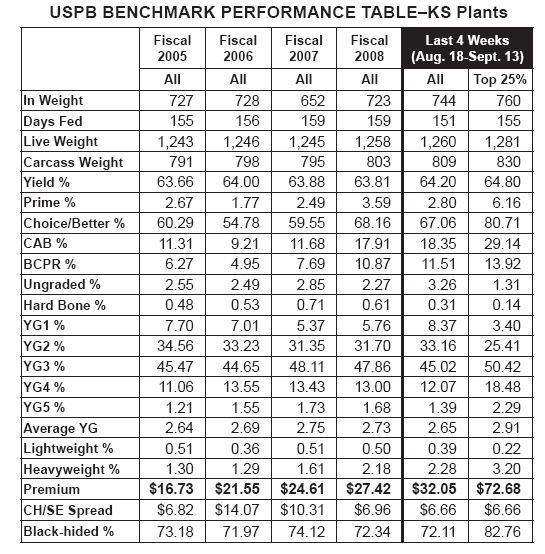 | Combined, nearly 40% of all black hided cattle received an additional premium for either CAB or BCPR during fiscal 2008. That’s 6.5% higher than the previous record. Quality Grade improvements were made from top to bottom. Prime was the highest in six years and Ungraded was the lowest in our history. Improvements in Quality Grade occurred throughout the industry. Across all carcasses from fed cattle graded by USDA in U.S. packing plants, 57.84% were Choice or higher. This was the highest industry average during our company’s history. However, in fiscal year 2008 USPB carcasses had 10.3% more Choice and Prime carcasses than the entire industry which was the largest advantage in company history. In fact, that advantage was over twice as large as the average for the previous five years at 4.47 percent. Yield, or dressing percentage, decreased for the second year in a row. |
However, it was similar to the company’s total historical average. Several feeding regions experienced prolonged periods of muddy pen conditions which kept yields lower through the winter. The yield of all USPB cattle was 0.38% higher than the yield threshold on the grids. This difference was smaller than the previous year so the yield benefit per head was smaller. Live pay weight and carcass weights were both record high during the fiscal year. A record was also set for apparent feedlot gain, which is calculated by subtracting live pay weight minus in weight. On average, 535 pounds of gain were added to USPB cattle during the feedlot finishing period. As a result, outweight discounts were also record large, driven by a record high percentage of heavyweight carcasses that were 1,000 pounds or more. Yield Grades decreased slightly compared to the previous | $35 per head will remain on age verified cattle 20 months or younger through May 31. Watch USPB’s UPDATE or call 866-877-2525 for more information. So, when placing calves this fall, USPB recommends that you continue to enroll calves in USDA approved ASV programs.w Unit Sales Decrease In FY 2008 The number of linked Class A and Class B units sold by USPB unitholders decreased during fiscal year 2008. Unitholders sold 6,480 linked units in fiscal year 2008, or 0.9% of the total outstanding linked units owned by USPB unitholders. That compares to 36,237 linked units sold from one unitholder to another during fiscal year 2007. The average price paid for a linked Class A and Class B unit during fiscal year 2008 dropped from previous year levels at $112.99 compared to $130.84 per linked unit in 2007. That was a 13.6% decrease in price year-to-year.w
C/S Spread Remains Steady USDA’s Choice/Select spread has traded in a narrow range since mid June. Grid premiums derived from quality grade have remained strong because USPB cattle have graded near historically high levels during this time period.w
USPB Offers EID Rebate USPB continues to offer its members an electronic identification (EID) tag rebate. Members who market cattle through our company with EID tags of any ISO approved brand and purchased from any supplier are eligible to receive a rebate of $1 per tag. To receive the rebate members must send their grade detail reports to USPB within 90 days of the date their cattle are delivered.w |
year. However, the plant averages on the USPB grids decreased more, which resulted in a larger yield grade discount per head during fiscal year 2008. Yield Grades across the industry also decreased slightly, or became leaner, compared to the previous year. This was the industry’s first decrease in yield grade 4 & 5 carcasses in eleven years. Next month we will summarize fiscal year 2008 cattle performance at our Brawley plant and the Base and Market grids. For a complete overview of carcass grid performance, be sure and attend the USPB Annual Meeting on December 10, 2008 in Kansas City, MO.w USPB Commits to ASV Premium Through May 31, 2009 U.S. Premium Beef will pay a $35 per head Age and Source Verification (ASV) premium through May 31, 2009. This commitment is dependent upon the Japanese trade remaining open to U.S. beef products and our plants continuing to be approved to export to Japan. However, even if the border opens to product from cattle under 30 months of age, instead of the current 20 months or younger, USPB’s commitment to pay |
| USPB Pays Record Grid Premiums... continued from page 1 | What you need to do |
occurring before the end of this calendar year as disclosed in our proxy statement on March 4. Our Board of Directors unanimously approved the sale of National Beef to JBS. Our unitholders also overwhelmingly voted to support the sale. We believe it is an opportunity to benefit our unitholders as well as our company and other beef producers who may want to market cattle through our company in the future. Selling National Beef to JBS would enable our unitholders to realize significant additional financial benefit from their ownership in USPB. It would also enable USPB to position itself, through its stock ownership in JBS, to more effectively compete in the beef processing and marketing industry in the future. And finally, it would give producers the opportunity to more efficiently market cattle through our company by delivering to processing facilities that are closer to their cattle feeding operations. During fiscal year 2008 we also continued to work to add more value to much of the beef and byproducts we process. We were again the number one exporter of fresh chilled and frozen beef to Japan, which is in part due to attracting cattle which qualified for our $35 per head age verified premium. Fiscal year 2008 was an unusual year relative to the number of linked Class A and Class B units that were traded by our unitholders. The announcement of our proposed sale of National Beef to JBS on March 4 significantly reduced the trading of units by unitholders during the balance of the fiscal year. As a result, the number of units traded in fiscal year 2008 decreased significantly from fiscal year 2007. On a very limited number of sales, USPB unit values decreased this past year, with most recent trades occurring at $120 per linked unit. For more information on unit sales see Unit Sales Decrease In FY 2008 on page 3. We are committed to generating more value out of our unique integrated beef company in the future. I encourage you to attend our annual meeting on December 10 in Kansas City for an in depth look at our fiscal year 2008 financial results and your company's plans for next year and beyond.w | COOL Set To Begin Mandatory Country of Origin Labeling (COOL) begins the week of September 29. A consortium of industry organizations and companies have developed documents that will enable industry participants to meet the requirements in as efficient manner as possible. Feedlots delivering cattle to our processing company will need to have completed and have on file a Continuous Country of Origin Affidavit/Declaration document with National Beef Packing Company, LLC (National Beef) before cattle can be scheduled for delivery. This document only needs to be completed one time. In addition, cattle feeders will need to designate the origin of each lot on USPB’s new Form B Showlist form. These documents are available on our website at www.uspremiumbeef.com, or members can request copies by calling our office at 866-877-2525. Feedlots will need affidavits from their suppliers—one for each lot. However, composite affidavits which cover cattle from multiple sources will be allowed. Feedlots will also need records that verify they have inspected the cattle for tags and brands that designate Mexico or Canada origin. Animals that were in the United States on or before July 15, 2008, are considered U.S. origin. Feedlots and/or producers who have supplied cattle to feedlots since then could generate an affidavit stating that they owned them on or before that date and that the cattle were in the U.S. at that time. Ranchers, stocker/backgrounders and auction markets can use industry-wide documents that were developed by the consortium of industry organizations and companies. USDA approved Age and Source Verified (ASV) programs are acceptable proof of country of origin. However, enrolling cattle in a USDA approved ASV program is not required to prove country of origin. For more information about COOL and to get a copy of National Beef’s Continuous Country of Origin Affidavit/Declaration, please visit our website at www.uspremiumbeef.com.w |

